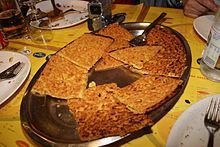Farinata
- This article is about the Italian food; for the 13th century Italian aristocrat see Farinata degli Uberti.
Farinata (which literally means floured in the Italian language) is a thin, crisp, pizza-like pancake from Liguria, Italy. Its original Genoese name is fainâ. Variations are eaten in many different Mediterranean countries and beyond. It is similar to the socca from Nice, France.
Cooking method

It is made by stirring chickpea flour into a mixture of water and olive oil to form a loose batter, and baking it in the open oven. A tin-plated copper baking-pan is used. Farinata may be seasoned with fresh rosemary, pepper and sea salt. Traditionally farinata is cut into irregularly shaped triangular slices, and enjoyed (with no toppings) on small plates with optional black pepper. Elsewhere in Italy (traditionally in Tuscany, where is called cecina (from the Italian word for chickpea, ceci), it is served stuffed into small focaccia (mainly in Pisa) or between two slices of bread, as it is traditional in Livorno. It is sold in pizzerias and bakers'.
Italian variations
On the Tuscan coast, south of Liguria, especially in the province of Pisa, Livorno, Lucca, Massa Carrara an approximately identical food, called cecina (ceci are chickpeas in Italian) or, in Livorno, Torta (di ceci) (Chickpea pie) is baked (with no rosemary used for toppings).
In Sassari, Sardinia, due to the Genoese origin of the city and language, la fainé genovese (genoese fainé), is a "historical" dish.
In Savona province (near Genoa), a version of farinata called farinata bianca (white farinata) is used. It is made with wheat flour instead of chickpeas flour.
The name Panissa or Paniscia in Genoese indicates a solidified polenta-like paste, made with the same ingredients than farinata, which can then be cut into strips to be fried, assuming the name panissette.
Variations outside Italy
In Algeria, karantita is a similar dish which is very popular. It is served hot and dressed with cumin and harissa.[1]
In Argentina and Uruguay (where many thousands of Ligurian people emigrated between the 19th and the 20th centuries) farinata is known as fainá, similar to the original Genoese name fainâ. It is often eaten on top of pizza (a caballo).
In Argentina Farinata is also eaten smothered with Dulce De Leche or Jam/Jelly.
In Uruguay,'olive oil' is very seldom or never used to make fainá. Olive oil is very expensive and not to the liking of many people so, more common types of oil such as sun flower, canola and corn oils are used - if you are lucky - and soya oil, which is very bad tasting but cheap - is generally used. So beware of eating fainá in Uruguay unless you know the pizzero well enough to ask what type of oil he uses.[citation needed]
In Gibraltar, where a significant portion of its population is of Genoese origin, it is known as calentita when it is baked or panissa when it is fried. They are typically eaten plain, without any toppings. These are considered to be Gibraltar's national dishes.[2]
Notes
- ^ La calentita, afaulxbriole.free.fr.
- ^ Calentita: Gibraltarian national dish
